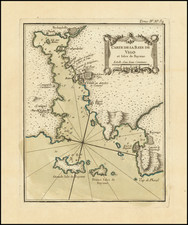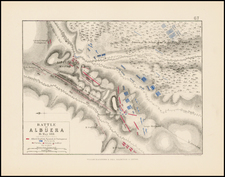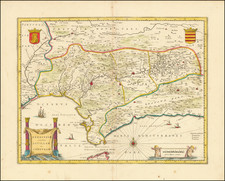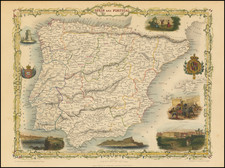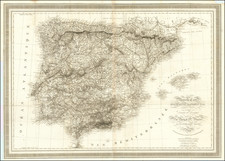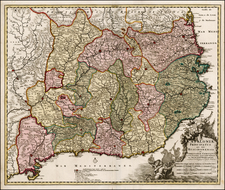Finely made hand drawn map of a roughly 25 mile section of the Coast of Valencian/Catalan coastline, south of the mouth of the Ebro River, likely drawn by a skilled French military engineer.
The map is oriented with northwest at the top, and shows the area from Peniscola Castle in the south to Les Cases d'Alcanar. Other towns noted include Benicarlos and Vinaros. The map notes the area and fortifications around Peniscola Castle, along with other prominent structures along the coast further north, including several towers and numerous soundings.
The map is elegantly drawn and elaborately finished in fine wash colors, with a colorful compass rose. The annotations on the back note that it is Map Number 12 and was likely part of a bound set of maps. While ordinarily this sort of map might be attributed to an engineering student, the size, elegance of presentation and the numbering are more indicative of an elaborate presentation piece, likely commissioned as a gift or tribute to a senior commanding officer in the French Navy.
The present chart was likely drawn during or immediately after the Seven Years War.
Peniscola Castle
The area around the castle was first inhabited in the 1st and 2nd Centuries BC. The Arab writer Al-Idrisi described Baniskula in the 11th century AD, and briefly described a Moorish castle overlooking the sea, but the first real description of the castle dates to the 13th century, when James I of Aragon noted the Muslim defenses. The castle was transferred to James's control in April 1229, after the last Almohad governor of Valencia, Zayd Abu Zayd, signed an accord surrendering various castles in eastern Spain.
In its current form, the castle was created by the Knights Templar, who planned to create a kingdom around Peniscola. James II of Aragon gave the castle to the Templars in 1294, along with the castles of Pulpís and Xivert. The Templars demolished the Muslim fortifications, and completely rebuilt the castle, completing work in 1307. The basic Templar core of the castle remains today.
The castle served as papal residence for Antipope Benedict XIII in the early 15th century, at which time some changes were made. The fortifications were significantly improved from the early 16th century onwards by military engineers and was redeveloped by military engineer Giovanni Battista Antonelli in the 16th century.
The Peniscola Castle was involved in various military conflicts of the Kingdom of Aragon, and later in the War of the Spanish Succession in the early 18th century, the Peninsula War and civil conflicts in the early 19th century.











